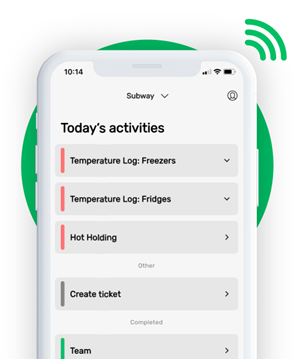PORK COOKING TEMPERATURE CHART BUNDLE
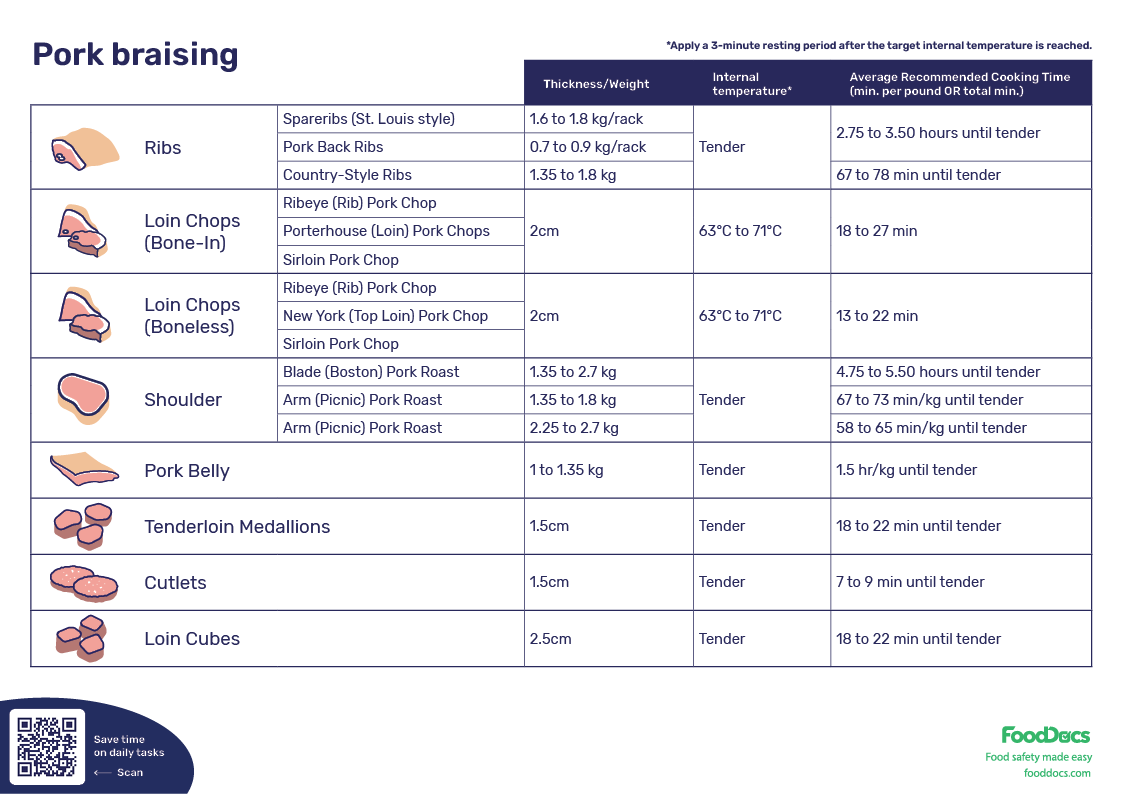



This is how our Digital Food Safety platform saves 20% of your time on daily tasks:
- Get upcoming task notifications
- Add data into the app
- Check the status of tasks in real-time

When food safety was still handled on paper, I typically spent a couple of hours per day getting the papers and going around checking or completing tasks… Now I can sit down and it's just all there in one place. It takes me 5-10 minutes.
Ruth B.
Store Manager
How to use FoodDocs' Pork Temperature Chart?
Correct internal temperatures have been established to address any potential foodborne illness that could result from eating undercooked pork. Each cooking method and cut of pork will vary the time and temperature of cooking. To make sure that you hit all the requirements every time, use a pork temperature chart.
Here are easy steps to get and use our Pork Temperature Chart:
- Choose the chart that suits your needs. Select the most appropriate Pork Cooking Temperature Chart from our list. The charts are divided according to cooking method.
- Familiarize yourself with the chart. Analyze the chart to see if it has the type of cut you need.
- Download the chart. Enter a valid email address and click on "Download." The chart will automatically be sent to your downloads folder.
- Print the chart and orient your team about it. Use the chart as a training guide for your food safety team. Discuss the importance of properly cooking pork to the target internal temperature.
- Pin the chart in a visible place. Place the chart near an area where it is
Moreover, you can also get other free charts, posters, and even templates for checklists from our food safety free template hub.
For a more intuitive way of recording cooking temperature readings, use FoodDocs' smart Food Safety Software. Our software can automatically generate a Cooking Temperature Log that you can use to record temperature readings. This log has built-in information on the proper cooking temperatures for pork.
The Ultimate Pork Temperature Chart: Perfectly Cooked Every Time
The recommended internal cooking temperature for pork is the most effective range of temperature for killing pathogenic risks.
Whether braised, fried, barbecued, broiled, or even in a stew, pork meat goes well with most recipes. The complex flavors brought by the different cooking methods of this type of meat make it a great protein for many types of dishes.
Additionally, flavor, texture, and suitability to dishes vary depending on the cut of pork. These types of pork cuts also require different cooking times and internal temperatures to achieve maximum flavor and the safest quality.
Key points covered:
- Correct internal temperatures have been established to address any potential foodborne illness that could result from eating undercooked pork.
- Pork is generally safe to eat when cooked to a minimum internal temperature of 63°C.
- The cooking method and cut of pork will vary the time and temperature of cooking.
- To make sure that you hit all the requirements every time, use a pork temperature chart.
- Cooking meat to the right internal pork cooking temperature ensures that it stays juicy and tender while being safe to consume as well.
- FoodDocs' smart Food Safety Management System can help you record pork internal cooking temperature with the help of automatically generated monitoring logs.
Learn how to use a pork temperature chart in this article and find out how you can manage your food safety operations without breaking a sweat.
WHAT WE'LL COVER:
- What is a pork temperature chart?
- Who needs a pork temperature chart?
- What should be the pork temp when done?
- Pork rib temperature chart
- Boston butt cooking temperature chart
- Pork tenderloin temperature chart
- Pork loin temperature chart
- What are the benefits of a pork temperature chart?
- Digital solution to monitoring your food safety operations
- Frequently Asked Questions
What is a pork temperature chart?
A pork temperature chart is a reference tool that can be used as a guideline for cooking pork using different types of cooking methods and cuts of meat. The different cuts of pork require varying cooking times but almost the same required cooking internal temperature.
Pork cuts have different toughness depending on their location.
Generally, the rib and loin cuts have the most tender textures, whereas the shank and shoulder are known to produce the toughest products. Shoulder and leg meats are tough because they are mostly used for everyday locomotion and have more connective tissue. As such, you can expect to cook these cuts longer, even with a small piece of meat.
Use a pork temperature cooking chart to know how long and at what internal temps you should cook your pork. Pork temperature charts are divided into five different cooking methods:
- Braising: slowly cooking a pork cut that is partially submerged in oil and water or broth to tenderize the meat, otherwise known as the pot roast method.
- Barbecuing: slowly cooking pork cuts at low heat directly at the heating source using a metal grill to hold the meat over a gas grill.
- Roasting/Baking: slowly cooking pork using dry heat inside an oven.
- Broiling: cooking cuts of pork with the heat source on top, with the piece of pork at least 10 to 12 cm away.
- Sauteing: cooking different cuts of pork using a small amount of oil in a pan over medium-high heat.
Your pork proper cooking temperature chart can be used to cook like a professional and ensure that the dish you are serving is safe and has great flavors. Each guide for a type of cooking process has its cooking temperature of pork and is based on information from food safety agencies such as the National Pork Board in the United States.
The general rule is to cook cuts such as chuck roast, loin, tenderloin, and pork chops at 63°C, whereas ground meats, such as ground pork, must be cooked at 71°C to 73°C.
This temperature safely kills the associated biological hazard. It is a food safety regulation and recommendation for pork cooking by the US food safety agencies.
Use a pork temperature chart and your trusty digital thermometer for accurate readings and temperature control.
Who needs a pork temperature chart?
A pork temperature chart is most useful for food establishments such as restaurants, production businesses, and retail meat shops that deal with many different pork dishes.
Additionally, a pork cooking chart is also useful for other food establishments such as cafeterias, fast-food chains, food trucks, care facilities that serve pork, and others. Using a pork temperature chart can promote proper food safety practices and can be used by food safety manager for training their teams.
It can also be used by retail stores, deli shops, and butcher shops specializing in meats. A pork temperature chart can be placed in the fresh meat section.
If you want to get smarter solutions, use FoodDocs' smart Food Safety Management System. Our intelligent software can automatically generate monitoring tasks that can be used to log internal temperature readings.
In addition, temperature logs for cooking pork can be set with standard internal temperature. If your team logs non-compliant readings, our system will automatically notify your employees and suggest corrective actions.
Use FoodDocs' smart features to ensure that your business operates according to food safety standards, especially for cooking pork dishes.
What should be the pork temp when done?
Generally, pork should be cooked to an internal temperature of 63°C with a 3-minute rest time before carving for food safety purposes. The resting time allows the residual heat to travel equally through the meat and ensures even cooking before carving. This rule of thumb applies to cuts such as chops, loin, and tenderloin.
This minimum cooking temperature is based on the effective internal temperature for significantly reducing the risk of infection from bacteria and parasites.
Pork internal temperature may vary in some cuts. For example, the temperature of ground pork must reach an internal temperature of 71°C. In other cuts of pork where there is high collagen content, the internal cooking temperature may be higher than 88°C to break down collagen.
Use a digital meat thermometer to accurately measure the internal temperature of pork, as cooking times can vary depending on factors like the thickness of the cut, the cooking method, and the initial temperature of the meat.
You can use our wide range of pork temperature charts based on the cooking methods mentioned above.
For pork temp charts based on pa particular cut of pork, please refer below.
For checking the internal temperature of processed pork products, such as ham, you can use our Ham Cooking Temperature Chart.
Pork rib temperature chart

Pork ribs are considered a tougher cut of meat and require accurate cooking for a more tender and flavorful result. Generally, for cooking methods like braising and roasting, the target internal cooking temperature for pork side ribs is around 88-96°C.
This target temperature range ensures safe cooking and maximum tenderness for pork ribs. For boneless rib cuts, the safe level of cooking temperature is only around 63°C. Remember to apply the resting time of 3 minutes before carving.
Boston butt cooking temperature chart

Boston butt is basically a cut from the pork shoulder. Cooking pork shoulder roast is a bit tricky. For high-temperature cooking methods like roasting, Boston butt cuts of meat are recommended to be cooked to a lower internal temperature of 63°C. This temperature will produce the ideal roast pork flavors and texture.
On the other hand, cooking this cut of meat using methods like braising will require an internal temperature of about 88-96°C. At this temperature, the collagen in the meat has broken down, resulting in tender, succulent, and flavorful pulled pork that's perfect for sandwiches and other dishes.
Pork tenderloin temperature chart

Pork tenderloin is a lean meat that benefits from careful cooking to avoid drying out. Aim for an internal temperature of 63°C for a well-done pork dish and to ensure safety and flavor for this type of pork cut. Let the pork rest for at least three minutes before carving.
This temperature balances tenderness and juiciness, making the pork tenderloin a delightful addition to your dinner table.
Pork loin temperature chart

Pork loin, a flexible cut, is best when cooked to an internal pork temp of 63°C to reduce the risk of food poisoning or parasitic infections. Apply an additional 3-minute resting time after removing the cut of pork from the source of heat. This results in a slightly pink center and juicy, flavorful meat.
However, if you prefer your pork loin to be more well-done, you can cook it to an internal temperature of 71°C, but be cautious not to overcook, as it may become dry.
What are the benefits of a pork temperature chart?
In addition to ensuring properly cooking pork to safe temperatures, a pork temperature chart can offer more benefits. There are too many cuts of pork that it is just not quite practical to memorize the ideal temperature for each cut.
Serving undercooked pork can potentially cause foodborne illnesses, which can significantly affect your food business.
Even with a very clean cooking environment, if you serve raw meat to customers, food safety risks will always be very high.
Using a pork temperature chart offers the following benefits:
- Reminder for accurate cooking. A pork temperature chart is meant to be used as a cooking guide for the basic rules of preparing pork. It is meant to ensure that food workers know at what temperature and the average cooking time they will cook a particular cut of pork to remove any food safety hazards.
- Food safety assurance. Cooking temperature charts can help guide employees with different cooking processes. For example, sauteing pork tenderloin will only take about 4-8 mins, whereas braising it will require 8-10 mins even if they are both 1.3 cm size. Cooking temperature for pork dishes is an important factor in keeping them safe. The minimum safe cooking temperature to kill the main pathogen in pork that causes food poisoning is 63°C.
- Food safety training for employees. A part of training food employees is orienting them about food safety and proper handling practices. They must also know particular terms such as carryover cooking and using a digital thermometer to measure meat temperatures.
- Food quality. Pork temperature charts help you avoid overcooking, which can lead to dry and tough meat. Cooking pork to the right temperature and approximate cooking time allows you to retain its natural juices, tenderness, and flavor, resulting in a more enjoyable dining experience.
All of these benefits are attainable with a well-structured pork cooking temperature chart. This document can become an important part of your food safety management system and can contribute to maintaining food safety compliance with proper temperature management.
The pork cooking temperature chart is a more specific version of the cooking temperature chart for meats, which gives you an overview of the most important internal cooking temperatures. Pair our pork cooking chart with your calibrated food thermometer for more accurate temperature readings.
Use this chart together with a calibrated digital cooking thermometer.
Digital solution to monitoring your food safety operations
Correctly cooking to the right pork internal temperature is part of your important food safety practices to maintain compliance with food safety laws. It must be regularly monitored to ensure consistency in operations. As such, it must be a part of your comprehensive food safety management plan to have a pork cooking temperature chart.
You can use our smart Food Safety Management System to save time, increase efficiency, and maintain compliance with all food safety laws and regulations. Our system allows you to switch from a paper-based food safety management system to a completely digital one without the hassle in just 15 minutes.
- Automatically generated Cooking Log for monitoring pork temperature
- Step-by-step instructions for more precise pork cooking
- Smart notifications for reminding members about monitoring tasks
- Real-time dashboard for an overview of your everyday food safety status
Automatically generated Cooking Log for monitoring pork temperature
Consistently logging pork cooking temperature readings is an essential task. Despite this, doing so can be tedious and take your focus away from other critical tasks. Make cooking temperature easier with the help of our software's automatically generated Cooking Log.
Access our Cooking Log using our free Food Safety App and log accurate temperature readings through any mobile device. In addition, this monitoring task is equipped with an auto-fill feature that prefills the readings based on your recent data log. With this, all you have to do is verify the information and save time on manually logging the information.
Our software's Cooking Temperature Log is automatically generated based on your business information and needs.
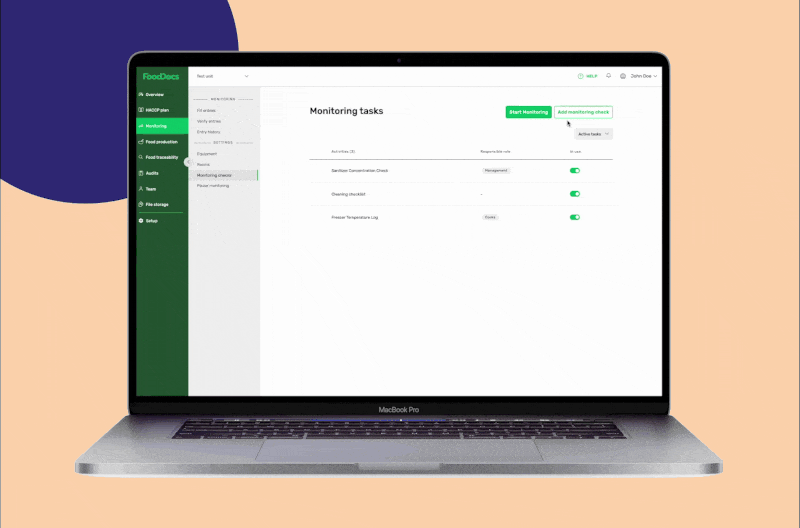
Customizable monitoring tasks from FoodDocs software
Step-by-step instructions for more precise pork cooking
Temperature reading requires the accurate use of a properly calibrated thermometer. Lucky for you and your team, all of our automatically generated monitoring tasks come with detailed instructions. Our Cooking Log features step-by-step instructions on how to use a thermometer to read the temperature.
You can also upload your own instructions with images or a video. Use this feature to train and remind your team on how to read pork internal temp properly.
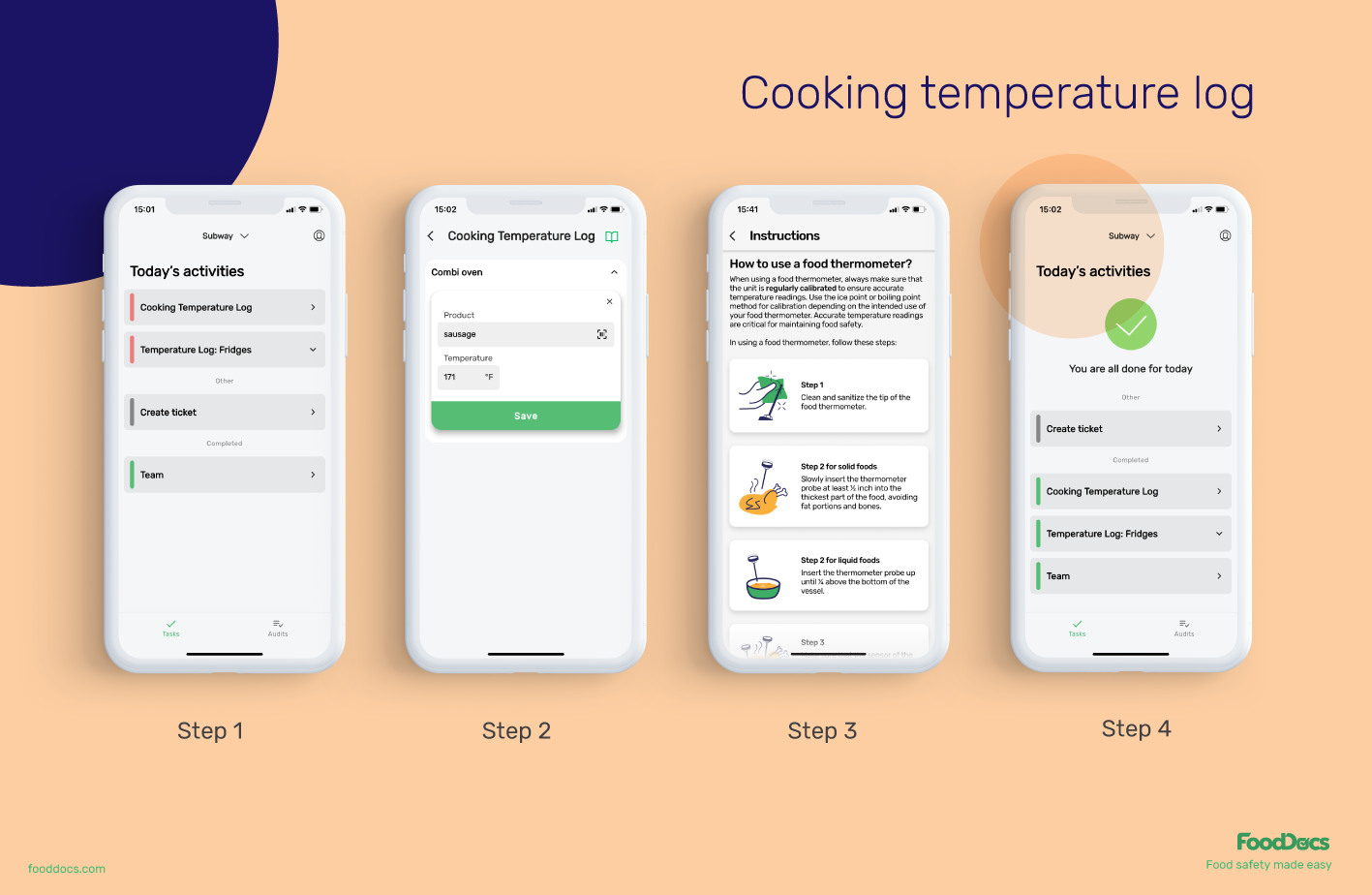
Cooking temperature log with instructions from FoodDocs software
Smart notifications for reminding members about monitoring tasks
To help your team remember critical tasks, such as reading correct temperatures on time, use our software's smart notification system.
This product feature sends intuitive alerts to food handlers whenever a critical task is due. With the help of our notification system, you can ensure that all pork recipes are perfectly cooked just the way they are intended to be.
Real-time dashboard for an overview of your everyday food safety status
To help you improve management efficiency, use FoodDocs' real-time dashboard. This feature will give you a quick overview of your food safety status. Quickly identify if a particular batch of pork dish was cooked correctly or if non-compliance was detected with the help of our real-time dashboard.
Spot food safety issues or tasks with problems more efficiently and ensure they are addressed correctly through our real-time dashboard.
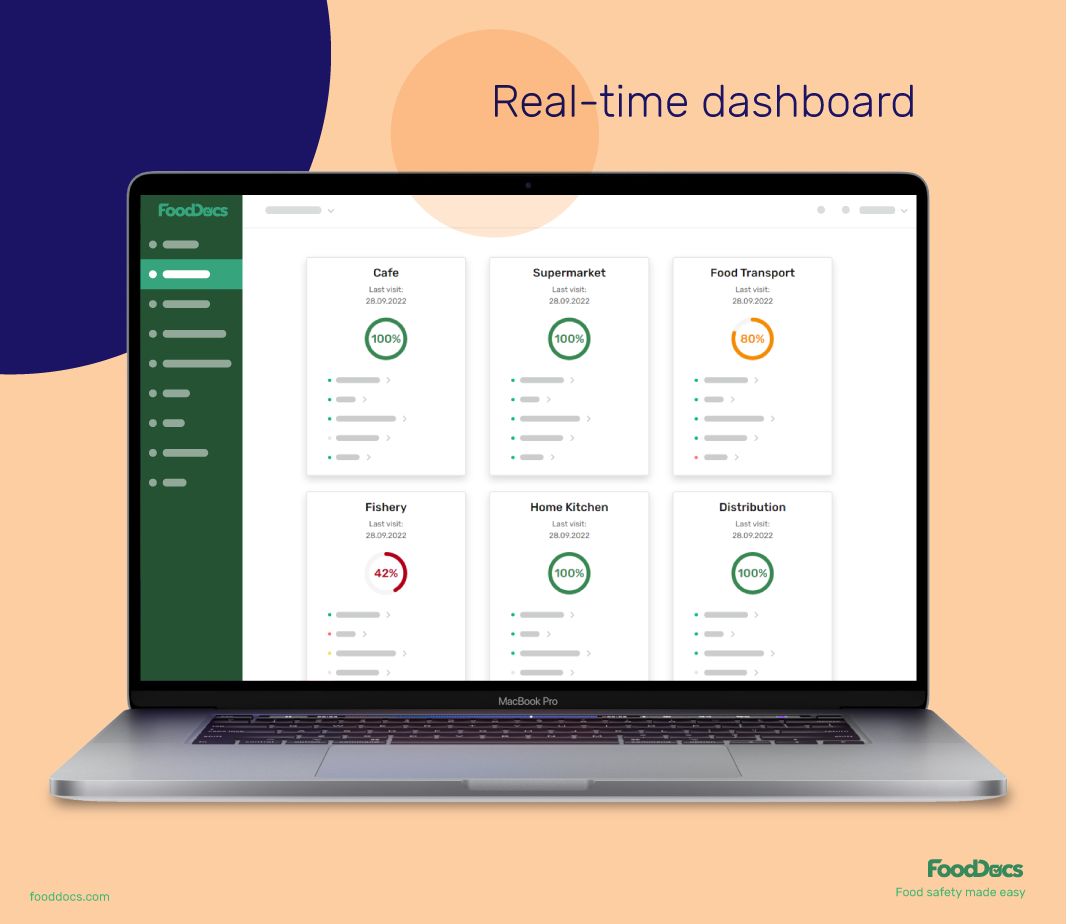
Real-time dashboard from FoodDocs software
Monitor your everyday operations with us and save at least 15x more time from micromanaging your food safety operations and focus more on improving your food business. With the help of our AI-powered solutions, you can accurately measure pork cooking temperatures and serve pork dishes safely or as requested by the consumers.
Get an intuitive Food Safety Management System built with the expertise of food safety professionals. All you have to do is spend an average of 15 minutes to complete your digital switch.
Experience a hassle-free digital food safety management system-making process with our smart software.
Book a free demo with our specialists to understand how our software can help you monitor and maintain food safety compliance.
Frequently Asked Questions (FAQs)
Is pork done at 71 degrees?
The recommended safe temperature for cooking any cut of pork is 63°C. This applies to cuts such as pork tenderloins, chops, loins, and roasts.
Is pork done at 76 degrees?
At an internal temperature of 76°C, pork is considered as done. At this temperature, flavorful pork can be harder to achieve as the minimum cooking temp for well-done cooking doneness is 71°C.
Is pork done at 60 degrees?
Ideally, you have to cook pork to at least 63°C with a three-minute rest time for carryover cooking from the residual heat to say that it is safe to eat. Cooking pork at 60°C can increase the risk of foodborne illnesses.
Can you eat pork at 63 degrees?
Yes! Food agencies have established that it is safe to eat pork that is cooked at 63°C internal temperature confidently.
